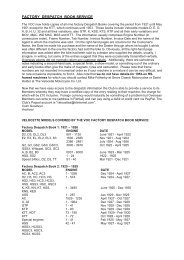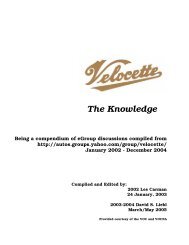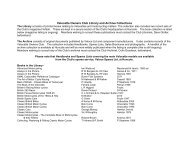The Knowledge - Velocette Owners Club
The Knowledge - Velocette Owners Club
The Knowledge - Velocette Owners Club
You also want an ePaper? Increase the reach of your titles
YUMPU automatically turns print PDFs into web optimized ePapers that Google loves.
B. <strong>The</strong> Engine<br />
B.1. Bottom End and Crankcase -<br />
L #198 Tony described the correct way to fit an oil seal to stop oil exiting the main bearing – now<br />
I will describe a “bodge”, that a fellow club member used to fix the same problem. Clean the inside of<br />
the sprocket with alcohol or some other solvent, place a circular bead of silicone around the part of the<br />
sprocket that abuts the main bearing boss. Smear light oil on the main bearing boss, slide the sprocket<br />
on and rotate at least one revolution. Lightly screw on the shock absorber, spring and nut. Leave it for<br />
24 hours, before reassembly.<br />
L #264 What methods have members of this group used to overcome slack oil pumps in<br />
crankcases? I have just come across this with an engine I am building out of autojumble parts and I<br />
am thinking of having the main oil pump body hard bearing chromed, anyone any comments .<br />
#281 <strong>The</strong> only method I have come across but never used, is to sleeve the crankcase – a skilled<br />
engineering job.<br />
#364 You can use grinding compound on a plate glass plate to remove the wear on the oil pump base,<br />
but I would expect a surface grinder to do a more efficient job. <strong>The</strong> only other problem I could think of,<br />
was if the pump was slack in its bore then when the crankcase warmed up the differential rates of<br />
expansion may allow air to be sucked into the pump. However I feel this would be unlikely.<br />
L #369 Anybody know how to get the flywheel off a two stroke? <strong>The</strong> engine freed off in my U last<br />
night, but that now means I can't lean on the stuck piston to undo the flywheel nut. My reading of the<br />
engine section drawing on www.<strong>Velocette</strong>owners.com is that the nut acts as an integral puller - or am<br />
I way off the mark? Also discovered that the Mag appears to have automatic advance - hence no cable<br />
for it. Despite standing for 50 years it still gives a (feeble) spark.<br />
#370 I am not familiar with the model U but I did own a GTP. I believe the nut is separate from the<br />
pulley/flywheel/sprocket assembly. If the engine is in the frame and the transmission is still intact, try<br />
putting it in gear and applying the back brake while trying to remove the nut. It may work but no<br />
guarantees.<br />
#380 Thanks for the reply. I discovered that the pulley was just bolted onto the flywheel - a home mod I<br />
think! <strong>The</strong> nut does however act as a puller for the flywheel, and I was able to both undo the nut and<br />
break the taper fairly easily by jamming the crankshaft against the conrod with a block of wood.<br />
Unfortunately I think I moved the flywheel round, so now have no idea where the Mag was timed at,<br />
but I am sure there must be a fairly easy way to re-time it when it comes to rebuilding the engine.<br />
#512 Here's my nightmare, from yesterday, which began when I followed the 'red book' instructions for<br />
fitting the oil pump back into the crankcase. "Heat up the case around the oil pump housing using a<br />
blow torch." Heat up? How hot? <strong>The</strong> BMS manual talks about "considerable heat". How considerable? I<br />
broke a corner off the oil pump's cast iron base plate, by hitting it off axis with a hardwood drift while<br />
trying to drive it back into the housing. A Good Samaritan, an old-time Velo expert, took pity on me,<br />
heated the case, withdrew the pump, cleaned up the abuse, replaced the base plate and refitted the<br />
whole thing. Now I know, having watched him, what considerable heat means. Blowtorch? Propane<br />
gas flame? Forget it. He used a 'cool' oxy flame. Here's the drill as I'd now write it. Heat the crankcase<br />
until it will easily char-grill a thick fillet of steak in thirty seconds. Continue heating until it is barely<br />
possible to remain in the same room as the crankcase. When the sound of racing fire engines can be<br />
heard, and the jaws on the vice are starting to melt, drive the oil pump into the housing. If it doesn't<br />
drop in with one gentle tap, you need more heat. Iif the manuals had hinted at the very considerable<br />
temperature needed, and given the hint that very little force is needed to insert the pump when the<br />
temp. is correct, I might have saved myself a lot of grief and my mate a lot of time.<br />
34





